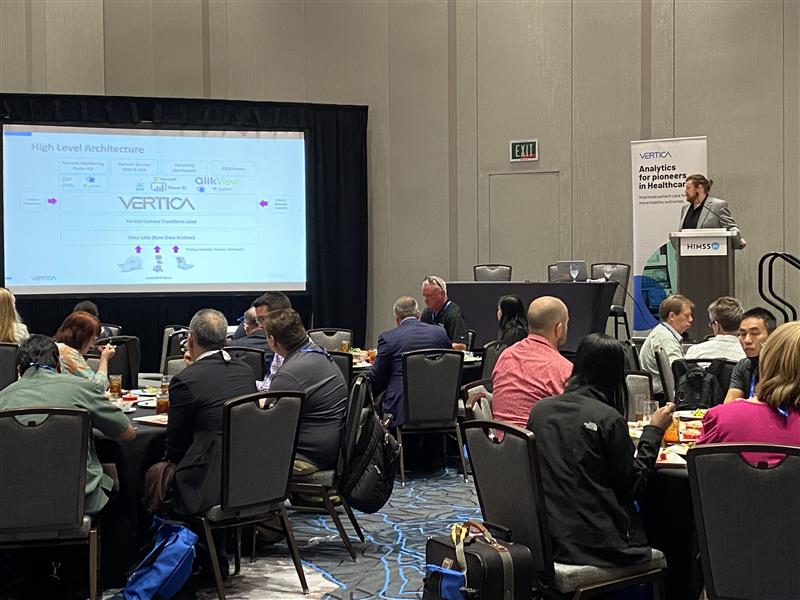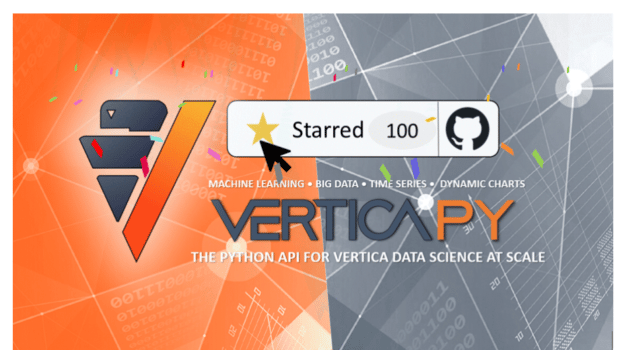
Vertica was a first-time sponsor at August’s HIMSS21 show in Las Vegas, the largest annual North American healthcare technology conference. While the show followed strict health and safety precautions to protect guests, attendance at the show was still quite light compared to what I’ve heard the show normally expects. Nevertheless, the conversations we had at the booth and throughout the show were great, and we learned a lot while we were there. I thought I’d share some of my thoughts and recurring themes from my many conversations.
The time for data-driven healthcare is now
Healthcare costs are rising significantly, especially in the US. In fact, they’re rising 1.1% faster than overall GDP, and IDC predicts healthcare will be 19.7% percent of total GDP by 2028, up from 17.7% now. Meanwhile, we’re getting poorer outcomes compared to similar countries around the world.

The Vertica booth at HIMSS21 show, Las Vegas, August 2021
Patients have more choices for care than ever before. In addition to traditional providers, they’re visiting Urgent Care facilities, retail clinics, and leveraging digital disruptors who have transformed the customer experience in other industries
The bottom line is that healthcare companies are under tremendous regulatory, financial, and competitive pressure to focus on delivering value-based care and patient centricity, and responding to both of those trends requires real-time and predictive insights based on all of the available data. With a data-driven approach, healthcare organizations can improve outcomes while lowering the total cost of care.
Data siloes abound
An organization-wide view of the data is particularly challenging for healthcare companies, who are often burdened with legacy hardware and software, multiple clouds and on-premises environments, point solutions that lack interoperability standards, and clinical, financial, and operational business units that have their own systems. Unifying data for operational, clinical, and financial insights was a key theme and initiative for many of the healthcare companies who visited our booth, as was interoperability, and that unification of data is a critical step towards becoming truly data-driven
There is interest and hesitancy around AI/ML
AI and ML are on the roadmaps of every executive in healthcare, but there are far fewer healthcare companies using predictive analytics in production. This is because the level of effort required to operationalize AI and ML is far greater than many, if not most, companies understand, especially at the outset. Not only are there technology challenges around getting AI and ML into production, there is also a lack of data science talent. New insights like population health and social determinants of health require integrating new and historic data sources and training models on massive volumes of data to produce accurate results. Predictive analytics can drive patient centricity by helping to deliver personalized and continuous healthcare.

The Vertica session at HIMSS21 was well attended.
Healthcare is moving to the cloud (or is it?)
Yes, and no. The long and slow march to the cloud for healthcare seems to be accelerating, as hesitancy around what workloads and data should go to the cloud becomes secondary to the need for cloud capabilities to achieve patient-centric and value-based outcomes. Still, companies have been slow to make the leap, and to the extent that a lot of healthcare companies are in the cloud, it’s because they are using SaaS-based offerings from their traditional vendors (EHR, revenue cycle management, and more) as opposed to adopting the integrated IaaS + PaaS offerings from the public cloud providers. Still, most healthcare companies, especially on the provider side, should expect and plan to be multi-cloud and hybrid cloud, with data silos across environments.
Why Vertica?
Our message to HIMSS booth visitors was simple: Vertica eliminates a great deal of the complexity that healthcare companies face in modernizing their data architecture, unifying disparate data volumes, and operationalizing AI & ML. Vertica enables multi-cloud and hybrid cloud environments, it removes the risk of current and future infrastructure choices, and it allows them to manage the explosion of data across the enterprise without compromising on speed or performance.
Most important, by leveraging an enterprise-wide view of the data and the broadest set of advanced and predictive analytic capabilities, healthcare organizations can address their most critical operational, clinical, and financial challenges, and finally become data-driven.
The time to become data-driven is now, and Vertica provides the capabilities healthcare organizations need to answer the call.
Learn more at our upcoming webinar!
For more information on how to get started on your journey towards data-driven healthcare, tune in to our webinar, “Become a Data Driven Healthcare Organization,” featuring Cynthia Burghard, Research Director for IDC Health Insights, on Thursday, September 23 at 11 AM EST. You can register for the webinar here.






